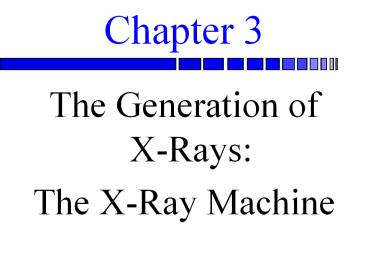The Generation of X-Rays: - PowerPoint PPT Presentation
Title:
The Generation of X-Rays:
Description:
The x-ray machine is divided into three separate circuits, each having a ... A transformer is an electrical device with no moving ... Voltmeter or Ammeter. ... – PowerPoint PPT presentation
Number of Views:55
Avg rating:3.0/5.0
Title: The Generation of X-Rays:
1
Chapter 3
- The Generation of X-Rays
- The X-Ray Machine
2
(No Transcript)
3
The X-ray Machine
- The x-ray machine is divided into three separate
circuits, each having a specific function but
collectively having one goal - the production of
a controlled x-ray beam. - The three circuits are
- Primary or tube filament regulating circuit
- Secondary or tube kilovoltage regulating circuit
- Timing circuit
4
Transformers
- A transformer is an electrical device with no
moving parts operates on the principle of
mutual induction that transmits current from one
circuit (primary circuit) to another (secondary
circuit) that are not electrically or physically
connected. - The two are magnetically connected in that they
are both wound around the same iron core.
5
Transformers
- Transformers are made up of four parts
- Primary coil
- Secondary coil
- Core
- Insulation
- In transmitting the current from the primary
circuit to the secondary circuit, alterations are
made in the voltage amperage.
6
Transformers
- This is due to the conservation of energy. A
transformer that raises the voltage is a step-up
transformer one that lowers voltage is a
step-down transformer. - The determining factor in whether a transformer
is step-up or step-down to what extent it
performs either of these tasks is the relative
number of windings in the primary secondary
coils.
7
Transformers
- If there are more primary windings than secondary
it is a step-down transformer, conversely if the
number of secondary windings is greater than the
number of primary windings it is a step-up
transformer.
8
Transformers
- Recall that when voltage goes up, the amperage
goes down. Therefore a step down transformer will
have increased amperage coming out. - We can decrease both the amperage the voltage
by using resisters.
9
Transformers
- The amount of voltage increase or decrease when
using transformers can be calculated using the
following relationship (which does not account
for transformer loss) - Applied voltage of primary windings
Delivered volts of secondary windings
10
Transformers
- For example, if a transformer has 10 times as
many primary windings as secondary (step-down)
110 volts are applied to it. What is the
delivered voltage? - Applied voltage of primary windings
Delivered volts of secondary windings - 110 10 X 1
- 10X 110
- X 11 Volts
11
Transformers
- According to the Law of Conservation of Energy,
energy can neither be created or destroyed but
can be changed to different forms. - The unit of electrical energy is the watt, which
is the product of voltage times amps. - Volts X Amps Watts
12
Transformers
- Or substituting
- Volts X Amps(primary) Volts X Amps(secondary)
- We can therefore see that an increase in voltage
will mean a corresponding decrease in amperage. - A transformer delivering 500 times the applied
voltage will deliver 1/500th of the applied
amperage
13
Autotransformers
- A variable or autotransformer is a transformer
with a single core. It allows us to fine tune the
amount of amperage voltage. Current is supplied
to this coil from an incoming line the voltage
for each turn of the coil is calculated as - Applied Voltage Voltage Per Turn
of Turns
14
Autotransformers
- For Example, if an autotransformer has 100 turns
in the coil and 100 volts were applied. What
would be the voltage for each turn? - Applied Voltage Voltage Per Turn
of Turns - 100 1 100
15
Autotransformers
- This is the fine tuner and on a whole, will be
increasing voltage for x-ray production.
16
PRIMARY or TUBE REGULATING CIRCUIT
- This functions to accomplish the first essential
for the generation of x-rays - The source of electrons (thermionic emission or
the boiling off of electrons).
17
The Primary or Tube Filament Regulating Circuit
- The parts of the circuit are
- Incoming voltage supply - 110 or 220 volts.
- Choke coil voltage regulator (variable resister)
- it decreases both voltage amperage. - Voltmeter or Ammeter.
- Filament or Step-down transformer - lowers the
line current to 3-10 volts 3-5 amps. - Cathode filament of the tube
18
The Secondary or Tube Kilovoltage regulating
Circuit
- This functions to accomplish the second third
essentials for the generation of x-rays - The means of accelerating the electrons
- Stopping them with great impact
19
The Secondary or Tube Kilovoltage regulating
Circuit
- The parts of this circuit are
- Incoming voltage Supply-110 or 220 volts
- Autotransformer - step-up
- Peak kilovoltage meter
- Power or step-up transformer to increase incoming
voltage to 30 to 120 kV - Rectification system-converting from AC to DC
current - X-ray tube
- Milliammeter - measuring the of e- passing from
the cathode to anode
20
The Timing Circuit
- This functions to control the predetermined time
that the high voltage is applied to the tube,
therefore controlling the time that x-rays will
be produced. - It is attached to the secondary circuit.
- The timing circuit is completely independent from
the primary secondary circuits.































